Sicong Leng
Refining Positive and Toxic Samples for Dual Safety Self-Alignment of LLMs with Minimal Human Interventions
Feb 08, 2025Abstract:Recent AI agents, such as ChatGPT and LLaMA, primarily rely on instruction tuning and reinforcement learning to calibrate the output of large language models (LLMs) with human intentions, ensuring the outputs are harmless and helpful. Existing methods heavily depend on the manual annotation of high-quality positive samples, while contending with issues such as noisy labels and minimal distinctions between preferred and dispreferred response data. However, readily available toxic samples with clear safety distinctions are often filtered out, removing valuable negative references that could aid LLMs in safety alignment. In response, we propose PT-ALIGN, a novel safety self-alignment approach that minimizes human supervision by automatically refining positive and toxic samples and performing fine-grained dual instruction tuning. Positive samples are harmless responses, while toxic samples deliberately contain extremely harmful content, serving as a new supervisory signals. Specifically, we utilize LLM itself to iteratively generate and refine training instances by only exploring fewer than 50 human annotations. We then employ two losses, i.e., maximum likelihood estimation (MLE) and fine-grained unlikelihood training (UT), to jointly learn to enhance the LLM's safety. The MLE loss encourages an LLM to maximize the generation of harmless content based on positive samples. Conversely, the fine-grained UT loss guides the LLM to minimize the output of harmful words based on negative samples at the token-level, thereby guiding the model to decouple safety from effectiveness, directing it toward safer fine-tuning objectives, and increasing the likelihood of generating helpful and reliable content. Experiments on 9 popular open-source LLMs demonstrate the effectiveness of our PT-ALIGN for safety alignment, while maintaining comparable levels of helpfulness and usefulness.
BenchX: A Unified Benchmark Framework for Medical Vision-Language Pretraining on Chest X-Rays
Oct 29, 2024



Abstract:Medical Vision-Language Pretraining (MedVLP) shows promise in learning generalizable and transferable visual representations from paired and unpaired medical images and reports. MedVLP can provide useful features to downstream tasks and facilitate adapting task-specific models to new setups using fewer examples. However, existing MedVLP methods often differ in terms of datasets, preprocessing, and finetuning implementations. This pose great challenges in evaluating how well a MedVLP method generalizes to various clinically-relevant tasks due to the lack of unified, standardized, and comprehensive benchmark. To fill this gap, we propose BenchX, a unified benchmark framework that enables head-to-head comparison and systematical analysis between MedVLP methods using public chest X-ray datasets. Specifically, BenchX is composed of three components: 1) Comprehensive datasets covering nine datasets and four medical tasks; 2) Benchmark suites to standardize data preprocessing, train-test splits, and parameter selection; 3) Unified finetuning protocols that accommodate heterogeneous MedVLP methods for consistent task adaptation in classification, segmentation, and report generation, respectively. Utilizing BenchX, we establish baselines for nine state-of-the-art MedVLP methods and found that the performance of some early MedVLP methods can be enhanced to surpass more recent ones, prompting a revisiting of the developments and conclusions from prior works in MedVLP. Our code are available at https://github.com/yangzhou12/BenchX.
Breaking the Memory Barrier: Near Infinite Batch Size Scaling for Contrastive Loss
Oct 22, 2024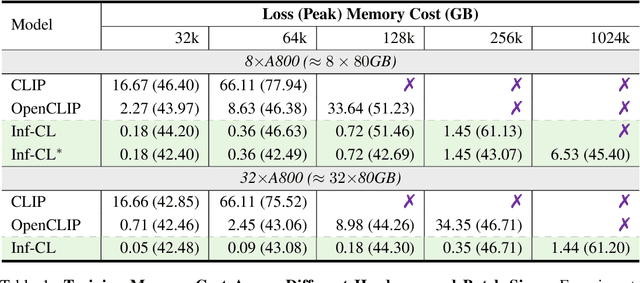
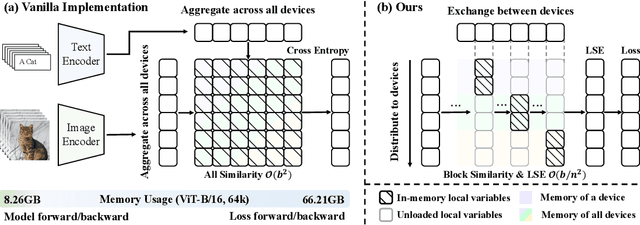
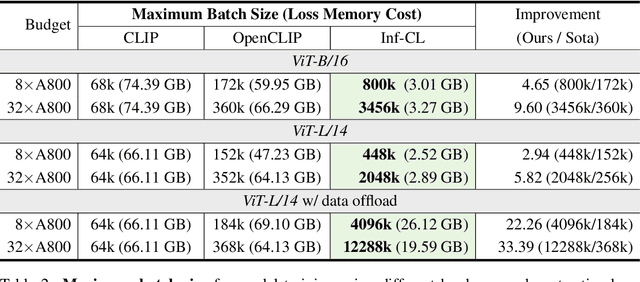
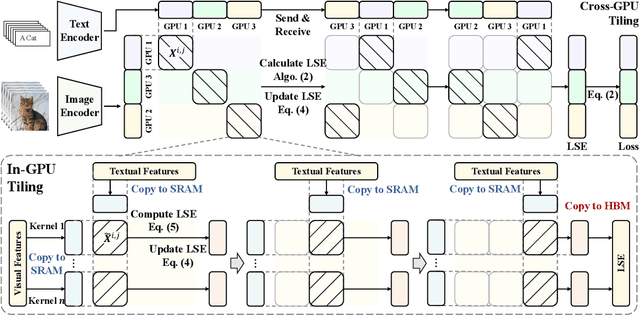
Abstract:Contrastive loss is a powerful approach for representation learning, where larger batch sizes enhance performance by providing more negative samples to better distinguish between similar and dissimilar data. However, scaling batch sizes is constrained by the quadratic growth in GPU memory consumption, primarily due to the full instantiation of the similarity matrix. To address this, we propose a tile-based computation strategy that partitions the contrastive loss calculation into arbitrary small blocks, avoiding full materialization of the similarity matrix. Furthermore, we introduce a multi-level tiling strategy to leverage the hierarchical structure of distributed systems, employing ring-based communication at the GPU level to optimize synchronization and fused kernels at the CUDA core level to reduce I/O overhead. Experimental results show that the proposed method scales batch sizes to unprecedented levels. For instance, it enables contrastive training of a CLIP-ViT-L/14 model with a batch size of 4M or 12M using 8 or 32 A800 80GB without sacrificing any accuracy. Compared to SOTA memory-efficient solutions, it achieves a two-order-of-magnitude reduction in memory while maintaining comparable speed. The code will be made publicly available.
The Curse of Multi-Modalities: Evaluating Hallucinations of Large Multimodal Models across Language, Visual, and Audio
Oct 16, 2024



Abstract:Recent advancements in large multimodal models (LMMs) have significantly enhanced performance across diverse tasks, with ongoing efforts to further integrate additional modalities such as video and audio. However, most existing LMMs remain vulnerable to hallucinations, the discrepancy between the factual multimodal input and the generated textual output, which has limited their applicability in various real-world scenarios. This paper presents the first systematic investigation of hallucinations in LMMs involving the three most common modalities: language, visual, and audio. Our study reveals two key contributors to hallucinations: overreliance on unimodal priors and spurious inter-modality correlations. To address these challenges, we introduce the benchmark The Curse of Multi-Modalities (CMM), which comprehensively evaluates hallucinations in LMMs, providing a detailed analysis of their underlying issues. Our findings highlight key vulnerabilities, including imbalances in modality integration and biases from training data, underscoring the need for balanced cross-modal learning and enhanced hallucination mitigation strategies. Based on our observations and findings, we suggest potential research directions that could enhance the reliability of LMMs.
AGLA: Mitigating Object Hallucinations in Large Vision-Language Models with Assembly of Global and Local Attention
Jun 18, 2024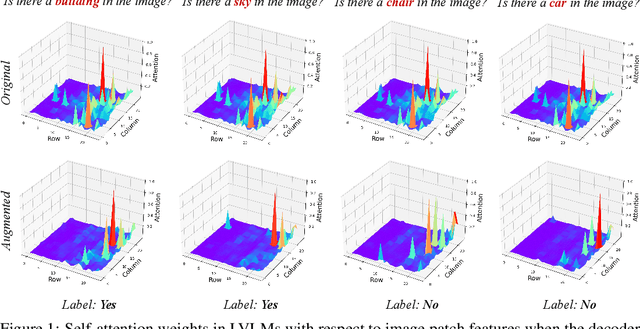
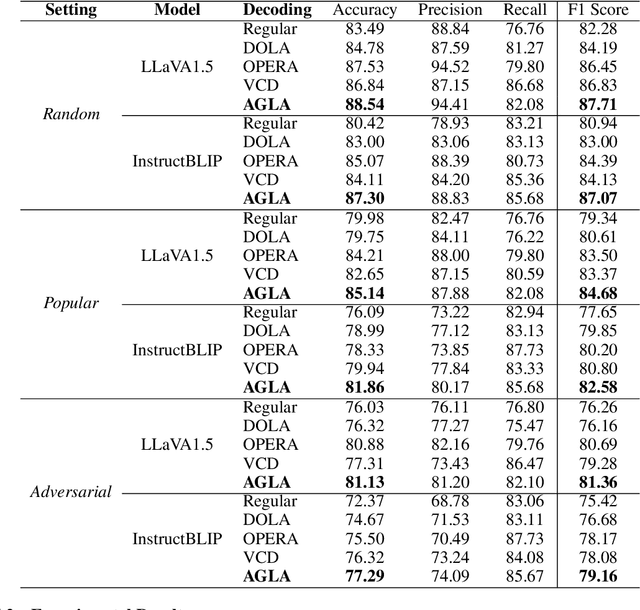
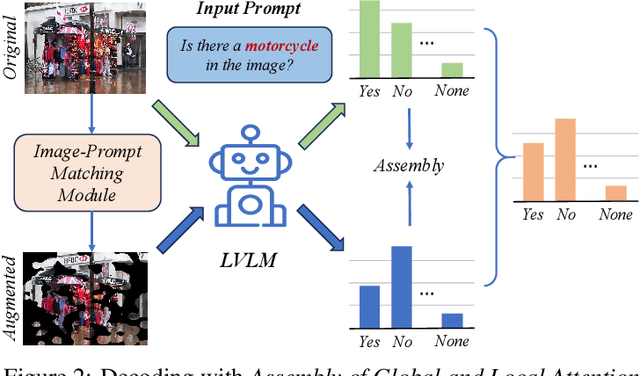
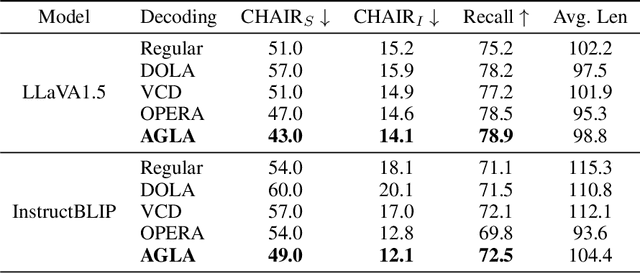
Abstract:Despite their great success across various multimodal tasks, Large Vision-Language Models (LVLMs) are facing a prevalent problem with object hallucinations, where the generated textual responses are inconsistent with ground-truth objects in the given image. This paper investigates various LVLMs and pinpoints attention deficiency toward discriminative local image features as one root cause of object hallucinations. Specifically, LVLMs predominantly attend to prompt-independent global image features, while failing to capture prompt-relevant local features, consequently undermining the visual grounding capacity of LVLMs and leading to hallucinations. To this end, we propose Assembly of Global and Local Attention (AGLA), a training-free and plug-and-play approach that mitigates object hallucinations by exploring an ensemble of global features for response generation and local features for visual discrimination simultaneously. Our approach exhibits an image-prompt matching scheme that captures prompt-relevant local features from images, leading to an augmented view of the input image where prompt-relevant content is reserved while irrelevant distractions are masked. With the augmented view, a calibrated decoding distribution can be derived by integrating generative global features from the original image and discriminative local features from the augmented image. Extensive experiments show that AGLA consistently mitigates object hallucinations and enhances general perception capability for LVLMs across various discriminative and generative benchmarks. Our code will be released at https://github.com/Lackel/AGLA.
VideoLLaMA 2: Advancing Spatial-Temporal Modeling and Audio Understanding in Video-LLMs
Jun 11, 2024



Abstract:In this paper, we present the VideoLLaMA 2, a set of Video Large Language Models (Video-LLMs) designed to enhance spatial-temporal modeling and audio understanding in video and audio-oriented tasks. Building upon its predecessor, VideoLLaMA 2 incorporates a tailor-made Spatial-Temporal Convolution (STC) connector, which effectively captures the intricate spatial and temporal dynamics of video data. Additionally, we integrate an Audio Branch into the model through joint training, thereby enriching the multimodal understanding capabilities of the model by seamlessly incorporating audio cues. Comprehensive evaluations on multiple-choice video question answering (MC-VQA), open-ended video question answering (OE-VQA), and video captioning (VC) tasks demonstrate that VideoLLaMA 2 consistently achieves competitive results among open-source models and even gets close to some proprietary models on several benchmarks. Furthermore, VideoLLaMA 2 exhibits reasonable improvements in audio-only and audio-video question-answering (AQA & OE-AVQA) benchmarks over existing models. These advancements underline VideoLLaMA 2's superior performance in multimodal comprehension, setting a new standard for intelligent video analysis systems. All models are public to facilitate further research.
Uncovering What, Why and How: A Comprehensive Benchmark for Causation Understanding of Video Anomaly
Apr 30, 2024



Abstract:Video anomaly understanding (VAU) aims to automatically comprehend unusual occurrences in videos, thereby enabling various applications such as traffic surveillance and industrial manufacturing. While existing VAU benchmarks primarily concentrate on anomaly detection and localization, our focus is on more practicality, prompting us to raise the following crucial questions: "what anomaly occurred?", "why did it happen?", and "how severe is this abnormal event?". In pursuit of these answers, we present a comprehensive benchmark for Causation Understanding of Video Anomaly (CUVA). Specifically, each instance of the proposed benchmark involves three sets of human annotations to indicate the "what", "why" and "how" of an anomaly, including 1) anomaly type, start and end times, and event descriptions, 2) natural language explanations for the cause of an anomaly, and 3) free text reflecting the effect of the abnormality. In addition, we also introduce MMEval, a novel evaluation metric designed to better align with human preferences for CUVA, facilitating the measurement of existing LLMs in comprehending the underlying cause and corresponding effect of video anomalies. Finally, we propose a novel prompt-based method that can serve as a baseline approach for the challenging CUVA. We conduct extensive experiments to show the superiority of our evaluation metric and the prompt-based approach. Our code and dataset are available at https://github.com/fesvhtr/CUVA.
Constrained Layout Generation with Factor Graphs
Mar 30, 2024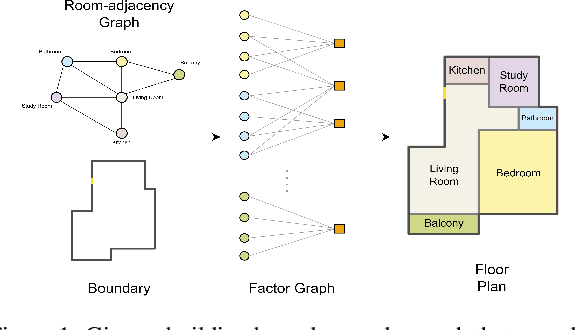



Abstract:This paper addresses the challenge of object-centric layout generation under spatial constraints, seen in multiple domains including floorplan design process. The design process typically involves specifying a set of spatial constraints that include object attributes like size and inter-object relations such as relative positioning. Existing works, which typically represent objects as single nodes, lack the granularity to accurately model complex interactions between objects. For instance, often only certain parts of an object, like a room's right wall, interact with adjacent objects. To address this gap, we introduce a factor graph based approach with four latent variable nodes for each room, and a factor node for each constraint. The factor nodes represent dependencies among the variables to which they are connected, effectively capturing constraints that are potentially of a higher order. We then develop message-passing on the bipartite graph, forming a factor graph neural network that is trained to produce a floorplan that aligns with the desired requirements. Our approach is simple and generates layouts faithful to the user requirements, demonstrated by a large improvement in IOU scores over existing methods. Additionally, our approach, being inferential and accurate, is well-suited to the practical human-in-the-loop design process where specifications evolve iteratively, offering a practical and powerful tool for AI-guided design.
Mitigating Object Hallucinations in Large Vision-Language Models through Visual Contrastive Decoding
Nov 28, 2023Abstract:Large Vision-Language Models (LVLMs) have advanced considerably, intertwining visual recognition and language understanding to generate content that is not only coherent but also contextually attuned. Despite their success, LVLMs still suffer from the issue of object hallucinations, where models generate plausible yet incorrect outputs that include objects that do not exist in the images. To mitigate this issue, we introduce Visual Contrastive Decoding (VCD), a simple and training-free method that contrasts output distributions derived from original and distorted visual inputs. The proposed VCD effectively reduces the over-reliance on statistical bias and unimodal priors, two essential causes of object hallucinations. This adjustment ensures the generated content is closely grounded to visual inputs, resulting in contextually accurate outputs. Our experiments show that VCD, without either additional training or the usage of external tools, significantly mitigates the object hallucination issue across different LVLM families. Beyond mitigating object hallucinations, VCD also excels in general LVLM benchmarks, highlighting its wide-ranging applicability.
Tell2Design: A Dataset for Language-Guided Floor Plan Generation
Nov 27, 2023Abstract:We consider the task of generating designs directly from natural language descriptions, and consider floor plan generation as the initial research area. Language conditional generative models have recently been very successful in generating high-quality artistic images. However, designs must satisfy different constraints that are not present in generating artistic images, particularly spatial and relational constraints. We make multiple contributions to initiate research on this task. First, we introduce a novel dataset, \textit{Tell2Design} (T2D), which contains more than $80k$ floor plan designs associated with natural language instructions. Second, we propose a Sequence-to-Sequence model that can serve as a strong baseline for future research. Third, we benchmark this task with several text-conditional image generation models. We conclude by conducting human evaluations on the generated samples and providing an analysis of human performance. We hope our contributions will propel the research on language-guided design generation forward.
 Add to Chrome
Add to Chrome Add to Firefox
Add to Firefox Add to Edge
Add to Edge